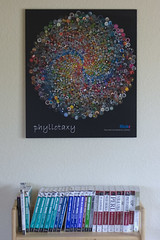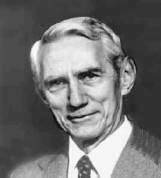Mochas and Modern Medicine
September 20th, 2005 There’s a drug rep riding up in the elevator with me to Doctor Schott’s office, a pretty young woman in her 20s. I know she’s a drug rep because in addition to a shopping bag with a big box that says Protonix on it, she is carrying a tray with four different Starbucks beverages on it. These will be offered to various receptionists she will encounter in the different medical offices in the building. She’s probably memorized the Starbucks preferences of her best clients. From what I can tell in my brief encounters with modern medicine, Starbucks is a huge factor behind the marketing of pharmaceuticals.
There’s a drug rep riding up in the elevator with me to Doctor Schott’s office, a pretty young woman in her 20s. I know she’s a drug rep because in addition to a shopping bag with a big box that says Protonix on it, she is carrying a tray with four different Starbucks beverages on it. These will be offered to various receptionists she will encounter in the different medical offices in the building. She’s probably memorized the Starbucks preferences of her best clients. From what I can tell in my brief encounters with modern medicine, Starbucks is a huge factor behind the marketing of pharmaceuticals.
I don’t see Doctor Schott very often, but the last time, 3 years ago, I saw more drug reps than patients, and today was much the same. “Another day of free samples and Starbucks, eh?” I inquire conversationally, just as the elevator door opens. She smiles and raises an eyebrow. I feel like I’ve offered the secret handshake.
When we exit the elevator on the 3rd floor, another drug rep is waiting to get in, and the two reps smile and greet each other by name. Even though their employers are probably direct competitors, they always seem very friendly with each other. There seems to be a kind of code-of-conduct with drug reps, and one of the codes is that you are friendly with other drug reps, and give them a certain amount of space.
The Protonix rep enters the first Doctor’s office on the hall, while I continue down the hallway to Doctor Schott.
The receptionist is only mildly irked that I’m 15 minutes late, and has me fill out a short form. It’s been three years since I last saw Doctor Schott. For the past three years I’ve been on a crappy HMO — one of the things that sucked about being a consultant — and I had to see a different doctor, in a lower-rent building with a lot more patients and more bad smells in the waiting room.
I remark about the preponderance of drug reps and Starbucks in the hallways to the receptionist, and she nods and sighs half-jokingly that they never bring *her* any Starbucks. Sure enough, when the elevator drug rep finally reappears, the tray of Starbucks is gone. I don’t know if the first medical office on the floor is a more desirable client for Wyeth, her employer, or if that office simply benefits from being closer to the elevator, or if maybe Doctor Schott has declared his office a Starbucks-free zone. Who knows?
The drug rep leaves a display box of Protonix brochures on a table in the lobby, and chits chats with the receptionist. Another code-of-conduct I’ve noticed about drug reps is this: they never actually talk about their drugs with the receptionists. It’s always personal chit chat — trying to establish or maintain a connection. In this case, the drug rep just got back from vacation and they talk about her trip. The receptionist seems genuinely happy to talk to her, but I wonder. She must have ten or twelve of these conversations a day. At the end of the conversation, she manages a quick “Can I leave you with some Protonix?” hands over the goods and that’s it.
I don’t know how long the Protonix brochures will last in Doctor Schott’s lobby. I don’t see other brochures touting specific drug brands left on the tables – most of the brochures he chooses to keep are about healthy lifestyles, or services, rather than specific drugs. Doctor Schott’s employees probably have to sweep the lobby of marketing material every evening.
Eventually, I get admitted to an examining room. I really like Doctor Schott — and it pissed me off that the crappy HMO I’ve had for the past three years wouldn’t cover him. He’s a nice guy with a slightly gruff exterior. He doesn’t come off as harassed and tired, the way my HMO doctor sometimes did. Doctor Schott is kind of like Wilfred Brimley’s younger, more well-informed brother. He gets lots of patients through positive referrals, and I can see why the drug reps like to visit him.
Doctor Schott’s nurse comes and takes my weight. I close my eyes as I step on the scale so I won’t have to see the result. Doctor Schott’s scale always make me twenty pounds heavier than my scale at home. Doctor Schott gave me some free Protonix samples a few years ago. It’s an acid reflux medication. As someone who continually battles with my weight, I’ve noticed that my incidence of acid indigestion is higher when I’m overweight. As I wait to see him, I wonder if a company which sells medications which treat an ailment which is worsened by obesity has an interest in keeping people fat?
I ask the nurse, who is now taking my blood pressure this very question. This throw her off, because she is trying to count. I ask her again when she’s finished. She gives me an odd look (I have to admit it’s an odd question) and says she doesn’t believe a connection is likely. I suppose I’m just being paranoid, I say. She says that although obesity *is* a contributing factor to acid reflux disease, it’s not the main factor. She treats lots of skinny people who have the condition. I ask her, “Is Starbucks a contributing factor to acid reflux disease?”
“Oh yeah,” she nods.
It’s the damn lattes, I think.
I’m seeing the good Doctor because I have a chronic cough. It’s the same ailment I saw him for three years ago, and he prescribes much the same things for it: an Allegra-like anti-histamine, an acid-reducer (not Protonix, this time), and some Flonase for my nose. He warns me that the insurance company probably won’t cover the Allegra, because they think the over-the-counter versions are good enough, although in his experience, the over-the-counter versions are not as effective as the prescription versions. I ask him why, is it the dosage? He says he’s not sure – it may simply be the placebo effect of a prescription drug versus an over-the-counter drug. I hope that his telling me this won’t reduce the effectiveness of the drug, which I’m probably gonna pay thru the nose for.
He also gives me a one-sheet entitled “Heartburn Hints” and circles the headline that reads “Make these lifestyle & dietary changes:” The list of 10 suggested changes begin with a) avoid fatty foods, b) avoid chocolate, c) avoid coffee. Fortunately, I don’t see Starbucks Mochas anywhere in the list. Thank god! In the bottom right corner of the one-sheet is a big logo for Prevacid. There’s a phone number at the top where I can get a free information kit: 888-558-ACID.
As I leave, there are three people waiting in the lobby.
Two of them are drug reps.







